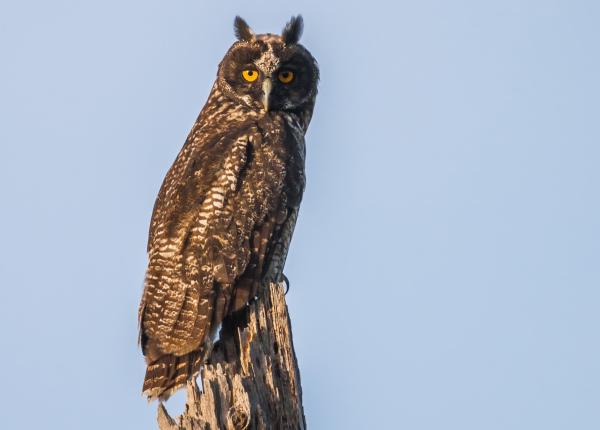Did You Know?
- Compared to most other owl species, the Stygian Owl consumes very few rodents
- On the flip side, it appears to eat more bats more often than most other owls.
How The Peregrine Fund is Helping
Though The Peregrine Fund doesn't work directly with Stygian Owls, our efforts in scientific research, habitat conservation, education, and community development help conserve birds of prey around the world. We also supply literature to researchers from our avian research library, which helps scientists around the world gather and share important information on raptor conservation.
Where it Lives
The Stygian Owl has a very patchy distribution from Mexico through Argentina and the Caribbean. It Central America it can be found in parts of Belize, Guatemala, Honduras, and Nicaragua. In South America its ranges includes portions of Bolivia, Brazil, Colombia; Ecuador; Paraguay, Venezuela, and Argentina. It can be on the Caribbean islands of Cuba and Hispaniola, the latter of which includes the countries of Dominican Republic and Haiti.
Depending on which region of its distribution this lovely and large owl lives, it can be found in quite a few different habitats and even at different elevations. In Mexico it is often found in mid-elevations, generally between 1500 to 3000 m above sea level. It makes its home in pine forests, pine-oak and cloud forests. However, just south of there, in Belize, researchers have documented this species from sea level to 800 m.
Traveling further south, into South America, this species' range extends withIn the Andes Mountain Range. There, this owl can be found in thorn scrub habitats and montane forest. It has even been observed hanging out in parks in urban areas.
What it Does
Like many owl species, the Stygian Owl is almost strictly nocturnal. This means it conducts all of its important activities - hunting, breeding, flying - under the cover of darkness. During the day, it finds a safe place to roost, often high up in a tree, where it is well camouflaged.
Why it needs our help
The Stygian Owl is classified as a species of Least Concern by the IUCN. However, research has shown that this owl's population is actually in decline, most likely due to loss of habitat. Another threat to this species is that fact that we know so little about it. Without having more knowledge on habitat use, hunting behavior, dispersal, nesting, and much more it is hard for conservationists to know how best to protect this species.
What it Eats
Have you ever heard the expression a "dog eat dog world?" Well, in the case of the Stygian Owl, it is more like a "bird eat bird world." Birds, mainly passerines, make up the bulk of this owl's diet. But, researchers in Belize observed on feeding on a Least Bittern! This owl will also feed on amphibians, such as frogs, insects like grasshoppers, crickets, and beetles, and bats.
Nests, Eggs, and Young
There is still so much to learn about the breeding behavior of this owl. Like most other owl species, the Stygian Owl probably doesn't build its own nest. Instead, it may use a stick nest built and subsequently abandoned by other birds, or it might nest directly on the ground.
Stygian Owl and the World Center for Birds of Prey
The World Center for Birds of Prey offers fun ways to learn about birds of prey. Interactive activities, tours, interesting videos and a children's room with activities from coloring sheets to quizzes to costumes. Owls are included among the education birds at the visitor center, providing visitors with a wonderful opportunity to see owls up close and learn about the wonderful and interesting adaptations they have in order to survive in their respective habitats. There is also a touch table with owl feathers and other natural objects available for exploration.
References:
Arizmendi, M. d. C., C. I. Rodríguez-Flores, C. A. Soberanes-González, and T. S. Schulenberg (2020). Stygian Owl (Asio stygius), version 1.0. In Birds of the World (T. S. Schulenberg, Editor). Cornell Lab of Ornithology, Ithaca, NY, USA. https://doi.org/10.2173/bow.styowl1.01
BirdLife International. 2016. Asio stygius. The IUCN Red List of Threatened Species 2016: e.T22689504A95214500. https://dx.doi.org/10.2305/IUCN.UK.2016-3.RLTS.T22689504A95214500.en. Downloaded on 11 August 2021.
Phillips R. 2011. Studying the Stygian Owl (Asio stygius robustrus) in Mountain Pine Ridge, Belize. Spizaetus 12:2-6










